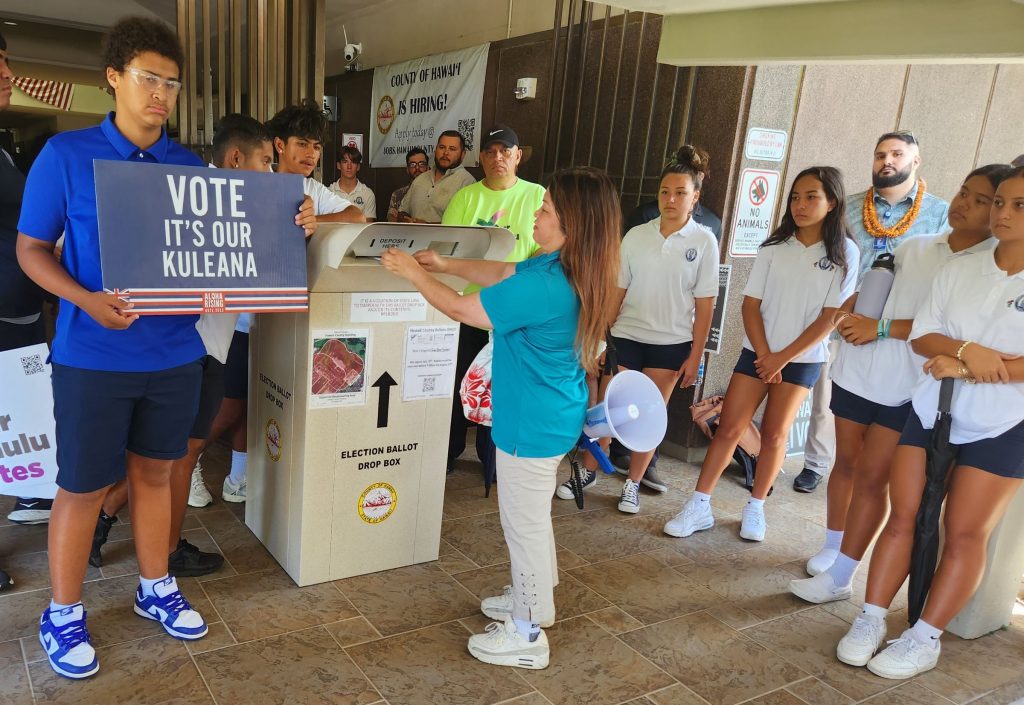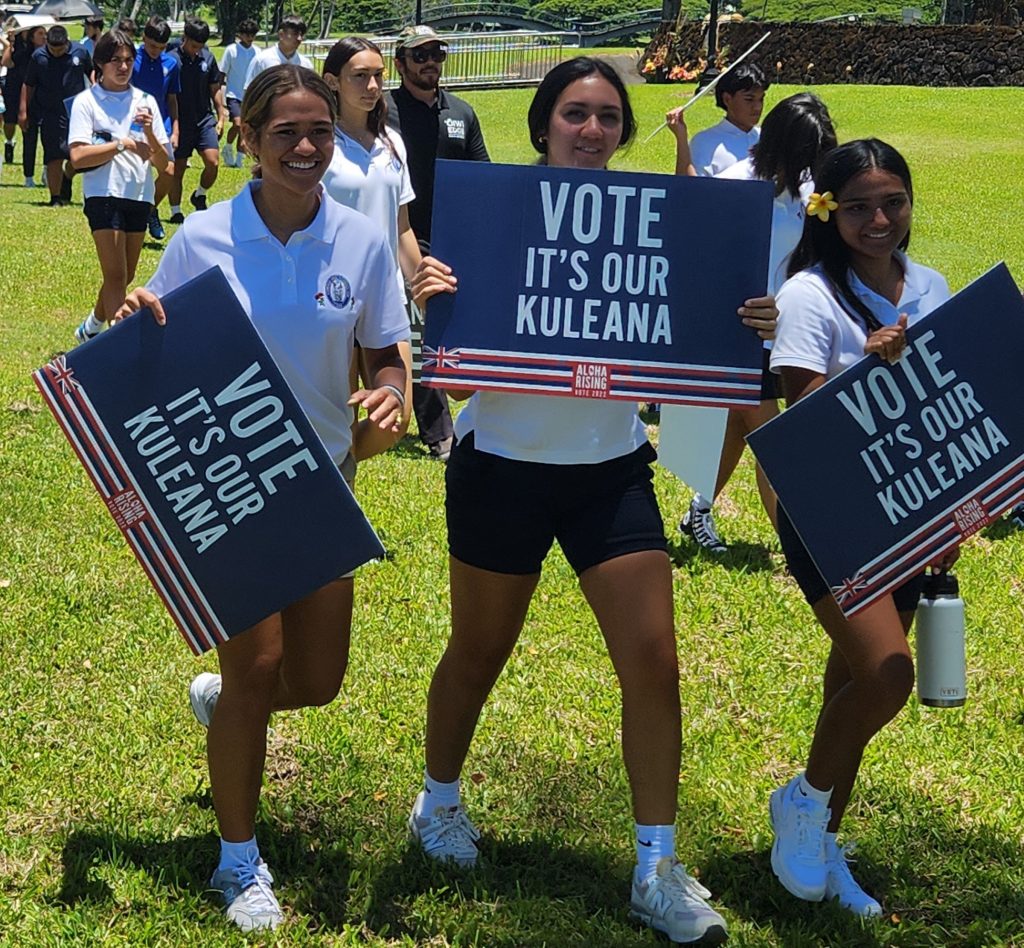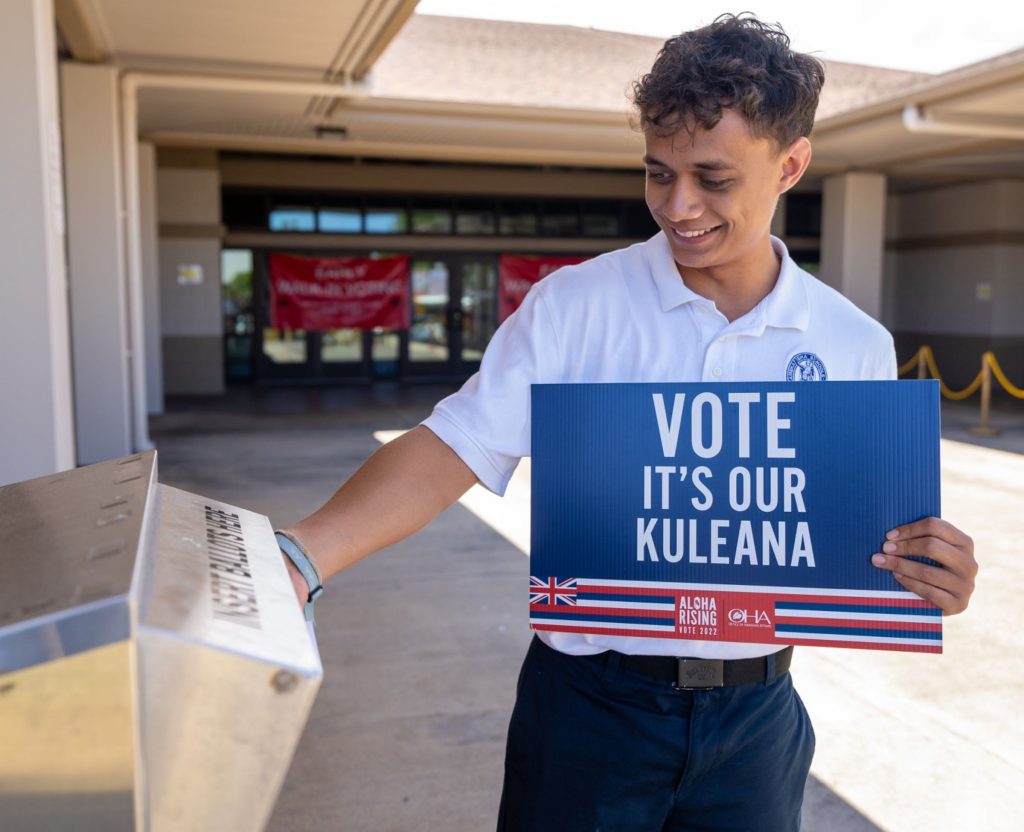‘The beginning of our new era’: Native Hawaiian students Walk to the Box to vote ahead of 2024 Hawai’i primaries
Kamehameha I conquered all but two of the main Hawaiian Islands by 1795. The great Hawaiian king has four commissioned statues — including one in Washington, D.C. — for a reason.
But military might only got him so far.

Kamehameha I respected his people’s power, so so instead of again going to battle to bring Kaua‘i and Ni‘ihau into the fold, he negotiated their peaceful ceding and in 1810 gained rule over the entire archipelago.
He did continue the traditional kapu system of laws and punishments; however, the great unifier crafted other policies showing that he was listening to all of his people. He enacted the “law of the splintered paddle” to protect commoners from being brutalized by powerful chiefs and also outlawed human sacrifice.
“Kamehameha was a man of tremendous physical and intellectual strength,” said King David Kalākaua, Hawai‘i’s last king, speaking about the man responsible for bringing the islands together as one nation. “In any land and in any age he would have been a leader.”
For 17-year-old Kamaha‘o Halemanu to have his voice heard late Friday morning while sign-waving during a Walk to the Box event along Kamehameha Avenue on Hilo Bayfront probably not much more than 350 feet away from the sculpted likeness of Kamehameha I himself keeping court in the background was powerful.
“That Kamehameha statue, that location in front of Bayfront is where actually my civic engagement journey began,” said the Kamehameha Schools-Hawai‘i senior, who is also president of the Associated Students of Kamehameha Schools, the student government at the Kea‘au campus.
The first time he participated in a Walk to the Box event, which is meant to rally voter turnout ahead of an election, this time the day before the Hawai‘i primaries, was 2 years ago.
He was one of about 10 to 12 students brought together by a Kamehameha Schools-Hawai‘i senior, who got them all registered to vote and put signs in their hands and organized the effort to get out the vote as part of her senior legacy project.
The 2022 event took place under the watchful gaze of the Kamehameha I statue in Hilo, too.
Halemanu’s second Walk to the Box had a few additional voices speaking up.
About 10 times more.
He was joined Friday by 100-plus of his classmates from grades 9-12 at Kamehameha Schools-Hawai‘i and Hawaiian immersion school Ka ʻUmeke Kāʻeo Public Charter School in Keaukaha. There also were several teachers, staff members and alumni who participated.
A total of more than 200 Native Hawaiians, Hawai‘i residents and first-time voters took part in Walk to the Box events that also including Honolulu and Wailuku, Maui.
They waved signs with messages including “I’m Hawaiian And I Vote,” “Our Kaiāulu Votes” and “Vote It’s Our Kuleana.”

In Hilo, they threw shaka, waved and yelled out to aunties and uncles, friends and family and everyone they could who drove by on the Bayfront roadway to hear their important message.
The group was rewarded more often than not — from both sides of the road — with honks and cheers in support. Even a few shaka were thrown back in solidarity.
Sign-waving lasted about an hour and then the caravan walked the less-than-a-quarter-mile trek from Bayfront to the Hawai‘i County Building to the site of the ballot drop box at the front entryway on the facility’s west side facing Aupuni Street, where several students cast their vote for the first time.
As the students were there, several voters from the greater community also took the opportunity to drop their ballots in the box.
Cyrus Johnasen, public information officer for Hawai‘i County Mayor Mitch Roth’s office and a Kamehameha Schools grad, also showed up for an impromptu lesson about what offices and departments are at each of the county buildings in Hilo and at the West Hawai‘i Civic Center in Kailua-Kona.
He then turned his attention to the reason the students were there.
“You can go online to the [Hawai‘i County Office of the County Clerk Elections Divison] and you’ll see that every day they post the number of ballots that have come in,” said Johnasen. “Now, why it’s so important, and why you guys are sign-waving, and why it’s so important that voting is part of our kuleana as Native Hawaiians is there’s 112,000 ballots that went out for this election. How many do you think have come back? Anybody?”
He got a couple of answers of 2,000 and 10,000, but the number was about 38,000 by about 12:30 p.m. Friday. Only about 34% of the total ballots had come back by about a day and a half before the election closes tonight.
That means all the decisions made, all the people voting, all the candidates to be elected, whether in the primaries or the general election in November, are being decided by just greater than 30% of the registered voters on Hawai’i Island.
That 30% is making the decisions for everyone.

“At 18 years old, it becomes your kuleana,” Johnasen said. “As you know, with your science, with this movement, with your social studies classes, with the civic engagement that Kamehameha is providing you, you don’t vote, no complain, right? No vote, no grumble is something that we used to talk about when I was a kid.”
His point: There needs to be more Hawaiians in office, more Hawaiian interests met, more local interests met. To do that, Native Hawaiians have to vote.
“So if every single one of you graduates and votes, we’ll be closer to where we want to be,” Johnasen said.
The 2023 ‘Imi Pono Wellbeing Survey found that 80% of Native Hawaiians voted in the 2022 general election compared to 83% of non-Hawaiians. Of those Hawaiians who were 18 to 24 years old, 55% voted in the 2022 general election while 64% of non-Hawaiians in the same age group did.
On the flip side, 93% of Native Hawaiians 63 and older cast ballots in the same election and 92% of non-Hawaiians did the same.
When it comes to representation, just 29% of Native Hawaiians thought their point of view is considered at least a little bit in Hawai‘i’s state government, with 28% saying moderately, 17% responding not at all, 17% swinging the other way to quite a bit, 5% saying they don’t know and 4% saying their opinion is extremely represented at the Capitol in Honolulu.
As a matter of trust, 34% of Native Hawaiians said they moderately trust the state to do what’s right for them, with 18% saying they don’t trust the state at all.
Bringing the question down to the county level, a few more Hawaiians said they moderately trust their local government to do what’s right for them at 39%. The number of people who flat out just don’t trust their local government either was 13%.
The ‘Imi Pono Wellbeing Survey is now in its fourth year and is a partnership between Kamehameha Schools, Lili‘uokalani Trust, The Office of Hawaiian Affairs, Papa Ola Lōkahi, and The Queen’s Health System.
It’s aimed at better understanding the physical, emotional and mental health of households throughout the islands, asking Hawai‘i residents 18 and older to answer questions related to community, relationships, education, health and culture.
The Walk to the Box events are part of Our Kaiāulu Votes, an initiative aimed at inspiring Native Hawaiians to get involved in the civic process to make their voices heard — especially youth — and encourage others to do the same.
A coalition consisting of Kamehameha Schools, the Office of Hawaiian Affairs and the Council for Native Hawaiian Advancement have provided the program every 2 years for at least the last three election cycles as part of students’ social studies classes that include civic engagement education.
The walk and sign-waving events are organized by organizations including Hui ʻOihana Hawaiʻi Island Native Hawaiian Chamber of Commerce, Ka Leo o Nā ʻOpio, Kanaeokana, Kanu Hawaiʻi, Kuaʻāina Ulu ʻAuamo, Papa Ola Lōkahi and Waiwai Collective.
Our Kaiāulu Votes also partners with schools throughout Hawaiʻi including all three Kamehameha Schools campuses on the Big Island, Maui and Oʻahu, Kanu o ka Aina Public Charter School, Ka ʻŪmeke Kāʻeo Public Charter School, Ke Kula Kaiapuni ʻo Pūʻōhala, the University of Hawaiʻi Office of the Vice President for Community Colleges and Windward Community College.
Kamehameha Schools-Hawai’i high school principal Lehua Veincent has been an educator for 38 years. This is his 13th year at Kamehameha Schools-Hawai‘i.

The 59-year-old said when he was growing up, Hawaiians were a very compliant people. They moved because that’s what was expected.
Now, as the generations have shifted and Hawaiian youth understands what happened in the past, Veincent said it’s become about reclaiming what his people lost — restoring what is there, but has not come to fruition and then regenerating what has laid dormant.
“Our kids are more cognizant,” he said. “I think the Mauna Kea issue brought up a lot of stuff. I think the [2018 Kīlauea] lava flow, when people went homeless, brought up a lot of things. So there’s been a lof of issues for our Hawaiian children who are familiar with Hawai‘i. It’s about understanding those issues.”
There are many issues the people of Hawai‘i, not just Native Hawaiians, face right now and it’s about understanding those issues, and Veincent said to really start changing the movement of where Hawaiians are, changes have to be made to who’s making the rules and laws.
Native Hawaiians still thrive as a people because of five components: genealogy, history, ʻāina, practice and language. That’s what students are taught at Kamehameha Schools.
“I do believe those five components are part of our kupuna, and it’s part of their kupuna, but it’s also part of their future as well,” Veincent said. “But it’s also about what they do with today. It’s about what are you doing and what are you going to do with what you just did today, with your family, with the people you see after school, with your athletic team members that are not here.”
Sometimes it’s not about participating in activities. It’s about taking part in life pieces you can share with other people.
So moving away from just activities, which are short-term and sometimes disconnected, to larger pieces of the puzzle that are more connected and foundational to who they are as a people.
Nāpuakaumakani Kalima-Martin, a teacher’s aide at Ka ʻUmeke Kāʻeo Public Charter School, was taught growing up to make sure whatever you have to say is important and it is heard, to never allow someone to belittle you.
She also learned kuleana — responsibility — is not a choice.

“You cannot allow somebody else … to do your responsibilities because if I don’t do it, then that means what I have to say is not important and that means I’m giving my mana to someone else, and in the ending, if I don’t want to do what I gotta do, then I have no right to say something, really,” said Kalima-Martin.
She said there was a time when Hawaiians were kept silent for reasons that even included their native language.
That time is long past and voting is very much a Hawaiian thing to do. Hawaiians used to choose who they wanted as their leaders based on who supported their beliefs the best and perpetuated certain cultural aspects.
Kalima-Martin said now more than ever is the time to teach Hawaiian youth to make sure they know Hawaiian ideas, opinions and thoughts should be valued and to say what they believe — no longer staying in silence.
Voting is important because it allows Hawaiians — and all people — to come together as a community to deal with issues and show that they matter and have priorities to accomplish.
“It’s important that we say something because if we don’t say something then, like I said, nothing will happen,” said Kalima-Martin.
She said programs such as Our Kaiāulu Votes and events like Walk to the Box are an opportunity to not just encourage people to get out and vote but to show them there’s nothing to fear or be ashamed about by making their voice be heard.
Because so often in the past Hawaiians were silenced and not given a chance to step up, Kalima-Martin said many tend to stay behind the scenes and quiet until they are encouraged by seeing others actively participating in the process such as waving signs, sharing their beliefs and ideas.
“It is an emotional thing to just see that there’s other kanaka who support you and who will have your back,” she said.
Kalima-Martin graduated in 2022 from Ka ʻUmeke Kāʻeo and participated in Walk to the Box that year as a student. She wasn’t old enough yet to vote then, and Friday was her first time.
She was one of those who dropped her ballot off at the county building during the event.
“It’s exciting to finally get to feel like, oh, my mana’o matters,” Kalima-Martin said.
Halemanu thinks it’s important everyone votes because that’s how change happens. It’s how we make the future we want, how we get the leaders we want to make the changes we need.
Voting is the people’s voice.
It’s even more important now, when one of the biggest issues facing Hawaiians is themselves.
“When it’s known that Hawai’i’s largest export isn’t the pineapple, it’s not corn or coffee, it’s Native Hawaiians — Native Hawaiians are the largest, just tangible ethnic group that leaves their own home,” Halemanu said. “They should not have to priced out of their own home, that’s not fair. So if we have to look to the future, and if I have to voice what I think Native Hawaiians should be focuced on, or one of the things I feel like we should be focusing on, it’s to make sure that our Native Hawaiians can stay in Hawai‘i.”
He was impressed by the turnout at Friday’s event, and couldn’t help be moved that it all happened where his civic engagement journey began just 2 years ago.
“Whenever I look to the Kamehameha statue, I always remember that change and how we are getting students to continuously show their voices and we will continue to do so,” Halemanu said.
He hopes Walk to the Box is the seed of civic engagement that grows inside all of those who participated Friday.
Furthermore, he hopes every honk of a vehicle that passed by and every interaction students had with someone walking or driving by while they were sign-waving is a life and perspective changed because they saw Native Hawaiians — Kamehameha Schools students — out on the curb, showing their support for voting.
“Ultimately, this is the beginning of our change,” Halemanu said. “This is the beginning of our new era.”
At the last update Friday afternoon, 41,611 ballots were returned to the Hawai‘i County Office of the County Clerk Elections Division out of the total 112,872 issued. That’s 37% turnout so far.
Polls close at 7 p.m. today.
Sponsored Content
Comments














